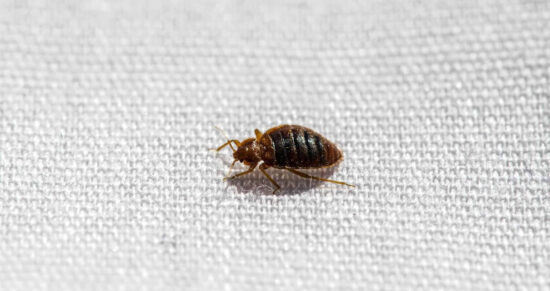Finding bed bugs in your home is never fun.
These tiny pests are tough to get rid of, and many sprays just don’t work anymore. But here’s some good news: extreme temperatures can kill bed bugs when chemicals fail.
The Quick Answer
The temperature that kills bed bugs depends on whether you’re using heat or cold. For heat treatment, 120°F will kill bed bugs and their eggs in about an hour. For cold treatment, you need 0°F for at least 4 days. Heat works much faster than cold, which is why most people choose hot treatments over freezing methods.
Bed bug eggs are the toughest to kill. They can survive temperatures that would kill adult bugs, so you need to be extra careful about time and temperature.
Why Temperature Works Against Bed Bugs
Bed bugs have survived for thousands of years, but they can’t handle extreme temperatures. When it gets too hot, their body proteins break down. When it gets too cold, ice crystals form in their bodies and kill them.
The best part about temperature treatments is that bed bugs can’t become resistant to them like they can with sprays. Heat and cold work every time when done correctly.
Heat Treatment: Hot Enough to Kill
Heat is the most popular way to kill bed bugs because it works fast and reaches places that sprays can’t touch.
The Magic Numbers for Heat
The temperature that kills bed bugs with heat starts at 113°F. Here’s what you need to know:
- 113°F for 90 minutes kills adult bugs and young bugs
- 118°F for 20 minutes kills adult bugs and young bugs
- 120°F to 125°F kills eggs (the toughest stage)
- Higher temperatures work faster
The key is keeping that temperature steady for the right amount of time. Just hitting the temperature for a few minutes won’t do the job.
What You Can Do at Home with Heat
Your regular household items can actually kill bed bugs if you use them right.
The Clothes Dryer Method
Your dryer is probably the best weapon you have against bed bugs. Put any infested clothes, bedding, or fabric items in the dryer on high heat for 30 to 45 minutes. Don’t pack the dryer too full because the hot air needs to move around freely.
This method works great because most dryers get hot enough to kill both bugs and eggs. It’s also free if you already have a dryer.
Hot Water Washing
Wash infested items in the hottest water they can handle, then put them straight into a hot dryer. The washing helps, but the dryer heat is what really kills the bugs.
Steam Cleaning
A good steam cleaner can kill bed bugs on contact if it reaches 160°F or higher. Move the steamer slowly over mattresses and furniture, about 12 inches every 30 seconds. This gives the heat time to kill bugs hiding just under the surface.
Steam cleaning works well for things you can’t put in the dryer, like mattresses and couches.
Small Item Heating
Some people use their oven to heat small items, but this can be dangerous. If you try this, keep temperatures under 140°F and never leave items unattended. There are safer portable heating devices made just for bed bug treatment.
Professional Heat Treatment
When bed bugs have taken over your whole house, professional heat treatment might be worth the cost. Pest control companies bring in powerful heaters that can heat entire rooms to 135°F or higher.
The process takes 6 to 8 hours and costs between $1,000 and $5,000 depending on the size of your home. It sounds expensive, but it usually works in just one treatment.
Professionals use special fans to blow hot air into every crack and corner. They also monitor temperatures throughout your home to make sure every hiding spot gets hot enough for long enough.
Cold Treatment: Freezing Bed Bugs Out
Cold can kill bed bugs too, but it takes much longer than heat. The temperature that kills bed bugs with cold treatment needs to be much more extreme than most people think.
The Numbers for Cold Treatment
Bed bugs are surprisingly tough when it comes to cold. They can survive temperatures that would kill many other insects. Here’s what actually works:
- 0°F for 4 days minimum
- Colder temperatures work faster but still take days
- Your home freezer might work if it actually reaches 0°F
Many home freezers don’t get cold enough or stay cold enough to reliably kill bed bugs. Check yours with a thermometer before trying this method.
What You Can Do with Cold
Freezer Method
Put infested items in sealed plastic bags, then place them in your freezer for at least 4 days. Make sure your freezer actually reaches 0°F and stays there.
This works well for shoes, books, small electronics, and other items that can’t go in the dryer. Just remember it takes much longer than heat treatment.
Winter Weather
Some people try putting items outside in winter, but this usually doesn’t work. Outside temperatures change too much, and items often don’t get cold enough in the center.
What Actually Works Best at Home
If you’re dealing with bed bugs and want to handle it yourself, focus on heat methods. They’re faster, more reliable, and easier to do safely.
Your Best DIY Option: The Dryer
The dryer method is your best bet for several reasons:
- It’s free if you have a dryer
- It reaches the right temperature easily
- It works on the items most likely to have bed bugs
- It’s safe when used normally
Just remember to check care labels first. Some delicate items might get damaged by high heat.
Steam for What You Can’t Wash
For mattresses, furniture, and other items that won’t fit in your dryer, a good steam cleaner is your next best choice. You can rent professional steam cleaners that get hot enough to kill bed bugs.
When DIY Methods Fall Short
Home methods work great for clothes and bedding, but they can’t reach bed bugs hiding in walls, furniture frames, or carpet padding. If bugs keep coming back after treating washable items, you probably need professional help.
When to Call Professional Exterminators
Sometimes the bed bug problem is just too big for DIY methods. If bed bugs have spread to multiple rooms in your home, it’s probably time to call the professionals. The same goes if you keep finding new bugs after trying DIY treatments, or if you’re dealing with a really heavy infestation where bugs seem to be everywhere.
Professional exterminators have equipment that can safely heat entire rooms. They use industrial heaters and fans that homeowners can’t buy or operate safely. These professionals also know how to monitor temperatures in hard to reach places and make sure the heat penetrates everywhere bed bugs might hide. When you want the problem solved quickly and completely, professional treatment is usually worth the cost.
Why Temperature Treatments Sometimes Fail
Even though temperature can kill bed bugs, treatments don’t always work perfectly. Heat treatments often fail when temperatures don’t get high enough in all the places where bugs are hiding. Sometimes people don’t keep the heat going long enough, or the equipment just isn’t powerful enough to do the job. Bed bugs are also smart enough to move away from hot areas if they can find cooler spots to escape to.
This is why professional treatments work better than DIY methods for whole room heating. Professionals have the right equipment and know how to use it properly.
Cold treatments have their own problems. Many home freezers don’t actually get cold enough to kill bed bugs reliably. Even when they do, people often don’t wait long enough for the cold to work. Thick items like heavy coats or pillows might not freeze all the way through, leaving bugs alive in the center. Home freezers also tend to warm up and cool down as you open them, which gives bugs a chance to survive.
Important Safety Warnings
Temperature treatments can be dangerous if done wrong. Never try using space heaters to heat entire rooms, bringing propane heaters indoors, using ovens for large items, or any homemade heating method that goes over 120°F. These methods cause fires and carbon monoxide poisoning every year. People have seriously injured themselves and burned down their homes trying these dangerous shortcuts. Stick to your dryer and steam cleaner for safe DIY treatments.
Even with safer methods, you need to be careful. Keep steam cleaners away from electrical outlets and never leave your dryer running when you’re not home. Don’t pack your dryer or freezer too full, and always check if items might melt or get damaged before heating them up.
The Reality About Temperature Treatments
Temperature treatments can definitely kill bed bugs, but they have limits. These methods are great at killing bugs and eggs on contact, and they can reach places that sprays can’t touch. They work without toxic chemicals, which many people prefer, and they usually work in one treatment when done correctly.
However, temperature treatments don’t prevent new bed bugs from coming back to your home. They also can’t kill bugs that aren’t present during the treatment, and they won’t work if you don’t do them properly. Unlike some chemical treatments, temperature methods don’t provide any long term protection after the treatment is over.
Making Your Treatment Plan
For most people dealing with bed bugs, the best approach combines different methods. If you’re dealing with a small problem that seems limited to your bedroom, start with your dryer for all washable items and use a steam cleaner on your mattress and furniture. This approach works well when you catch the problem early and the bugs haven’t spread throughout your home.
For bigger problems where bugs have spread to multiple rooms, you should probably consider professional heat treatment for the whole house, then use your dryer for ongoing prevention. Professional treatment costs more upfront but usually works better than trying to heat rooms yourself with inadequate equipment.
It’s important to set realistic expectations about any bed bug treatment. Even the best temperature treatment might not get every single bed bug in your home. You might need a follow up treatment or need to combine temperature methods with other approaches like mattress covers or targeted spraying in problem areas.
The good news is that temperature treatments usually work much better than sprays alone. When done correctly, heat and cold can solve bed bug problems that seem impossible to fix. Remember that prevention is just as important as treatment. Check for bed bugs regularly, especially after traveling or having guests stay over. Catching them early makes temperature treatments much more effective and less expensive.


